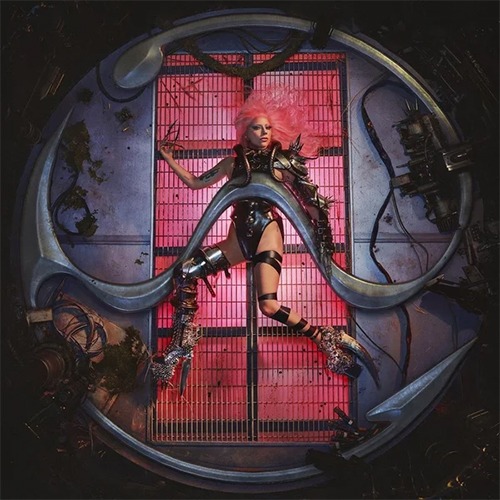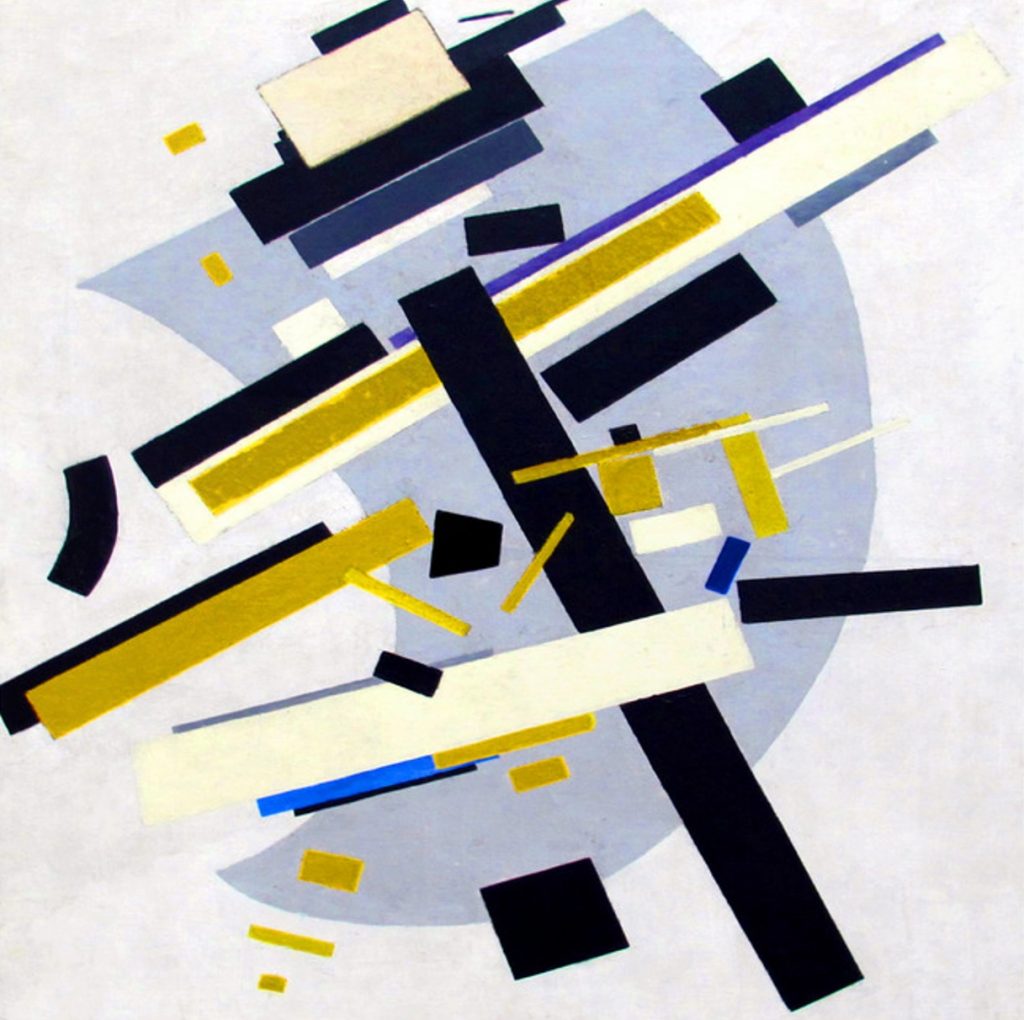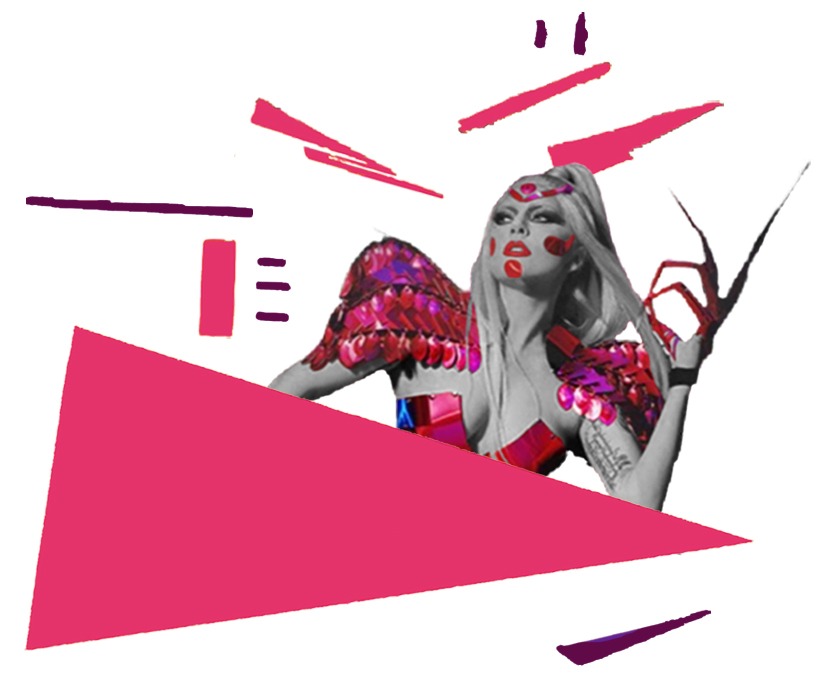[For the one-year anniversary of Lady Gaga’s album Chromatica, this is Chloé Toscano’s companion piece to last year’s essay “Lady Gaga’s Chromatica is the Pocket-Friendly ‘Meow Wolf’ of Pop,” which you can find right here.]

i. MOTHER MONSTER
IN 1915, THE ART WORLD was rattled when an artist named Kazimir Malevich undermined art as a whole, not much unlike Lady Gaga did. She took the world by its dormant senses and dragged it out of a lull. She set off to conquer the things she believed in, and she wanted to do it with art. So she stood atop the mountain of ludicrous apparel and pleasantly welcomed club culture music that she began with. And with each creation, she meta-cannibalistically fed off her self-derived absurdity and took it one step further. The world watched in awe as she savored every bit of the taboos that she would freshly slaughter on the regular. She put away the bland and mechanically churned rainbow Fruity Pebbles that had grown to be the Pop Music industry. Delicious, but somewhat uninteresting after a couple bites. She rabidly sunk her freaky fake teeth into the exotic flesh of her labors’ fruits and tore the everyday limb from limb so that she could reassemble her own brand of artist. She is Lady Gaga, also known by many as “Mother Monster.” Gaga reinvented the meaning and purpose behind “the Image” and has served up bottomless combos of radical aesthetic divergence. Her starting point relied on a Maximalist sensibility, larger than life theatrics, and an aesthetic of decadent excess. It was infused with not-so-subtle tinges of the strange and unknown. And these elements bred with her existing elaborations to create a new kind of art: an all-in-one breathing and ambulatory art that was herself. The music was almost an extra at this point, the trail she left behind as she went forth with her visually creative crusade. But what was she trying to say? It was, at times, difficult to decipher the message through the juxtaposed bizarre. But thanks to her most recent album, it’s shifted. She made an album that maintains an absolute existence, created from nothing familiar. Its raw, alien nature leaves room for audiences to conduct new feelings due to their interaction with the music. So the audience is no longer just an audience, looking in from the outside, mouths slightly ajar. They’ve been allowed to join in and share in the supreme passion that drips from her newest concoction, Chromatica. This is the New Suprematism.
Though Kazimir Malevich’s approach was less colorful, it still was provocative at the time. He challenged the purpose of art’s existence with the invention of a new artistic movement called Suprematism. And with this movement, Malevich sought to eliminate the importance of superficiality and reduce art to forms so primal that it forced its viewers to experience the artwork as a “pure feeling” instead of feebly looking upon an image that was either well-rendered or merely pleasing to the viewer. Suprematism slowed down the interaction between art and audience. It caused a reexamination of the form before them. Therefore, it’s fascinating that decades later, we’d see this movement begin to manifest in an industry that is characterized by fast-paced and insensate escapism: the Pop Music industry.
The association of oneself with the popularization of visual elements, such as imagery, has become predominant in marketing the faces of Pop Culture. It’s a culture that rests upon expedited and widespread recognition of newness. Therefore, association via image appropriation has become a great way to form these fast, familiar connections. Hence, the Image’s role is being contested once more.
ii. ENSLAVEMENT OF THE IMAGE
There’s an expression that’s been etched into many minds. It instructs us to “not judge a book by its cover.” But it seems that popular culture is making its departure from this perhaps outdated construct. In fact, the cover now speaks for some music albums with words being wholly omitted. Prince’s decision to legally turn his name into a symbol appears to have been a prophetic move that foreshadowed the identity compacting today’s artists are doing. Sawayama’s SAWAYAMA is sparking some “image inception” with a title that not only doubles as the artist’s actual name and an album cover of Sawayama. There’s also Taylor Swift’s Folklore, The Weeknd’s After Hours, Kanye West’s My Beautiful Dark Twisted Fantasy, and Lady Gaga’s Chromatica, to name a few more fully visually reliant album covers. Today, Pop Stars are going out of their way to make sure they’re purposefully associated with specific visuals. Judging a book by its cover is the new Pop Culture. This is what I meant by “association via image appropriation.”



An example of this outside of the realm of just album covers is the famed “Meat Dress.” Assuming that Gaga didn’t choose to sport a meat dress because she wanted to appear like she’d shown up insides-out for the VMAs, it was a genius self-branding move. It turned heads, and, in an instant, she went from Pop Star to epochal effigy, all by the clothing on her back. Similarly, like the Billie Eilish-identifying BLOHSH. When you see that weird little humanoid symbol, you see Billie, or a janky restroom symbol given the rarity you’re not familiar with, Billie Eilish. Either way, the BLOHSH is a condensation of those familiar entities.
What does this have to do with Suprematism? “Visual appropriation” is a crucial step closer to art fulfilling its demands. It begins the simplification process by reducing something as complex as a living and breathing individual by bottling it in the form of a visual or, in Gaga’s case, an iconic “living” style that never stays put, always evolves, and never conforms. Her ephemeral style is her image. That goes to show how versatile the Image’s services can be. In Gaga’s peculiar case, not having a specific appearance is her image. Still, it’s a way of exploiting the amenities that accompany visual elements. But these are its simple beginnings because the familiar still blocks the path of “spiritual purity.” According to Malevich, there can be no “spiritual purity” or “true art,” while what is recognizable still taints the subject. Suppose you were to transpose today’s “image exploitations” onto a timeline of artistic movements. In that case, they’d likely fall right into the Cubist era, an early unraveling of art into primary forms, but unclear on the intellectual and emotional “why.” Cubism was nothing but a reconstitution of familiar forms, not too different from Ed Sheeran throwing on a pair of trainers with every outfit and making them his “trademark.” Aside from the fact that Cubism was visually appealing due to its introduction of a new perspective in aesthetics, it was still conceptually-robbed art for art’s sake. It was not uncontaminated new. But it was nonetheless a rite of passage into Suprematism. Therefore, not to be overlooked. Cubism was the rise of the collective point of view, as opposed to the redundant first-person. It disposed of the fixed point of view that came with the “Renaissance Mode’s” first-person perspective and shattered it into multiple perspectives that coexist in the same work. And this is the fluidity that Chromatica gifts its audiences. Except, instead of offering a selection of viewpoints, Chromatica gifts its audience the tools needed to craft a DIY point-of-view.
iii. CHROMATICA, THE NEW SUPREMATISM
Malevich was described as the “Father of Suprematism.” Today, a contemporary Suprematism is located in the work of a Mother — Mother Monster that is. She’s again renewed herself and released more than dance music and visual wonders this time. Because Chromatica exemplifies art for art’s sake, propelling its audience into a generation of pop that subordinates its message and imagery to the supremacy of pure feeling. In other words, Chromatica seems to have figured. It. Out. A blissful union of her previous works, but this time, it is not a reconstitution of things we’re familiar with. It’s made from the scratch-produced, completely unfamiliar elements that can only lie in one’s mind: this time, Gaga’s personal accounts. But there’s a void left for each individual audience member to fill in with their own interpretation. The interpretational void is the “supreme feeling” that each “experiencer” will generate. And they create the feeling via their unique perception of the album and how they choose to explore and understand it. Chromatica is limitless because it exists differently in the mind of each who encounters it and doesn’t trap the audience into seeing or hearing only one thing. The below excerpt by Kazimir Malevich provides a competent diagnosis of Suprematism. And Gaga has made confident that Chromatica abides by every law, with a few modern adaptations.
An artist is under a vow to be a free creator […] An artist is given talent in order that he may present to life his share of creation and swell the current of life, so versatile. Only in absolute creation will he acquire his right. And this is possible when we free all art of philistine ideas and subject matter and teach our consciousness to see everything in nature not as real objects and forms, but as material, as masses from which forms must be made that have nothing in common with nature. Then the habit of seeing Madonnas and Venuses in pictures, with fat, flirtatious cupids, will disappear. Color and texture are of the greatest value in painterly creation — they are the essence of painting; but this essence has always been killed by the subject.
[Kazimir Malevich, From Cubism to Futurism to Suprematism, 1915]

Gaga took a risk when she decided to omit the fat, flirtatious cupids that have traditionally permeated Pop throughout the decades. But she seems to have made it work, and “Stupid Love” topped the charts even without the help of an inappropriately aimed love arrow. Who knew that this lawlessness could secure nine VMA nominations and five wins? Sarcasm aside, Chromatica is self-existing and unpolluted by anything found in nature, from its actual making to its content. Chromatica was produced majorly using computers, which, in a way, makes it artificially organic. It even works against nature via by giving its audience the means of turning their cerebral spaces into self-enclosed universes of their own.
The original Suprematism was composed of natural and straightforward forms unrelated to any subject in particular. The Contemporary Suprematism that’s fulfilled by Chromatica comes from its sound. And like early Suprematism, it exists independently of a topic and resembles nothing other than the feeling it embodies. Even most of the collaborative content was shared and worked on remotely, except for “Rain on Me.” It’s a new age of narrating art from nothing. And the result is a free and independent product of “supreme creation.” But Chromatica is not an autotrophic work. Like other Suprematist works that rely on the “supreme feeling” they can only produce with the help of audience interaction, Chromatica cannot be self-sustaining and cannot provide its own energetic release. It simply “is” until it can be experienced in the limitless minds that will encounter it. As the artist, Lady Gaga has released it so that it may prompt these interactions.
Malevich believed that art before Suprematism followed a purely conscious path and that Suprematist works would reign supreme due to their unique ability to force the intuitive to reveal itself through one’s unconscious. Chromatica is a parallel universe that, according to Gaga, unites conflicting realities. In the Manifesto of Chromatica: Part 1, she discusses the two competing realities in which she simultaneously resided. Gaga describes one as her “earth reality” and the other as her “dream reality.” Chromatica is a place where they can peacefully coexist. And the feeling that characterizes Chromatica is said by Lady Gaga to be spread through sound. Sound is the vehicle and life force through which Chromatica communicates. And this proclaimed “life force” is the equivalent of the initial color and texture that was described by Malevich to be the “essence” of painting. However, in music, the essence takes on an audible form.
On Episode 3 of Gaga Radio, Lady Gaga hosted a casual chat with Sir Elton John regarding their collaboration, “Sine From Above”, and expressed that the song is about “the healing power of sound.” The lyrics in Chromatica revolve around emotional hardship and turmoil. Still, the sound that accompanies the words is not contaminated by the subject matter because the music is what carries the message, not the other way around. Chromatica latches onto the minds it encounters like a virus in need of a host. The symbiosis creates the pristine energetic release that is the pure art form sought after by Suprematism. Not unlike a Mindflayer, Chromatica cannot thrive without its audience, its hosts.

iv. MOTHER MINDFLAYER
I mean that in the most flattering manner that one can be likened to a Mindflayer. The giant, fleshy, slimy, and loud creature popularized by the Stranger Things series is not what I have in mind. So try to undo the visual branding that’s polluted Mindflayers, courtesy of Netflix, and stash it away in the Upside-Down, where it belongs. Because as far as grotesque parallels and Lady Gaga go, I drew my line at meta-cannibalism. In comparing Chromatica to a Mindflayer, I refer to a bedazzled monster, so curious in appearance that it cannot be deemed as beautiful, nor can it be hideous. Because, again, just like the content that inspired Chromatica, it merely exists. Lady Gaga’s past is a massive influencer behind Chromatica, and just like something that cannot be changed, anything that lies in the past also, like a beautifully flawed Mindflayer, simply exists, whether you like it or not. Chromatica is a crudely, honest conglomeration of emotion. And unfortunately, complex emotion and inner turmoil is something that’s been thoroughly basked in shame and repulsion. It’s been swept under a rug and stamped with a Capital T for Taboo. Come time to begin work on Chromatica, Mother Monster was ravenous. Since Gaga can’t resist digging into a hearty Taboo with a side of pizza, it was time to kill.
Wikipedia describes the Mindflayer as a “monstrous humanoid aberration.” I’ve listened to Chromatica, cover-to-cover, 537 times and counting since it’s release. So this is a description that struck me as familiar because Chromatica presents this way as well. It departs from the comforts that lie in the conventional and unravels the monster, one’s biggest enemy: their mind. It addresses the concept of resembling a human or oneself but the deceit that exists therein when one fails to radically accept and live their truths. The early Mindflayers that were first mentioned in the 1970s duped their prey with a human appearance. Chromatica also falters in presentation but reels in its audience differently than a humanoid-presenting Mindflayer. People go in thinking they’re investing their time into listening to an album. Yet, they’re actually in for an intangible experience. Suprematism mimics this deceitful lure to create a beneficially hostile arrangement between artist and audience. The artist tricks the audience in order to educate them. So there is truth in the lie. It draws an audience in like any artwork might, and taps into their subconscious while interacting with it. Despite its claims to being “Absolute Art,” Suprematism is Demi-art. Without an audience to interact with, its “spiritual purity” isn’t generated. Likewise, without its “hosts,” Chromatica has no mind to Flay and no way of feeding its existence. Gaga confirms this in the fourth and final episode of Gaga Radio when she says [to a fan]:
The music itself was healing me and it was my life force. So thank you so much because what you’re reminding me in this moment is that the other half of my life force is you. I can hear a sound and turn it into a song but unless you hear it, it doesn’t matter.
[GAGA RADIO EP.4, Guest TCHAMI, 2020]
Like with any work of Suprematism, Lady Gaga is saying that in order for Chromatica to “matter,” it needs an audience. Without a mind to interact with, Chromatica doesn’t exist and therefore no feeling is conjured. The monster requires a host. The new future of Suprematism rests in the flaying abilities of Chromatica. It’s a trailblazer and the portable, farther-reaching Black Square of today. Chromatica is the “Polly Pocket” of Suprematism due to its portability. It coexists with its audiences’ “earth realities” as it therapeutically feasts on their subconscious, helping them understand what they’ve not yet explored. It lovingly scalps every morsel of ignored and dismissed emotion, revealing their un-confronted truths. And every single mind that encounters Chromatica is a unique multi-verse in which the go-anywhere album-experience hybrid resides. Lady Gaga made Chromatica to heal herself, this time focusing on only matters that had never before been admitted in her work. She then unleashed her Friendly Flayer so that it could thrive in the wake of others’ traumas and stashed truths, nudging them towards the salvation it brought her. In yet another episode of Gaga Radio, the star expressed how she felt upon releasing Chromatica and how this release differed from work she’s put out in the past.
Usually, I feel like something dies when I put a record out, like when something dies, or someone died. And with this album, it’s the first time I felt like something died that no longer serves me, like an exorcism. You know?
[GAGA RADIO EP. 2, Guest BURNS, 2020]
This further supports the notion that Chromatica is the world’s new friendly neighborhood Mindflayer with an endless supply of digital “sound tentacles” from which it may exist and operate in an infinite amount of minds at any given time. Chromatica appears to be the only recent “concept” album that seems self-aware of its place in the digital streaming world of music. There’s a stark contrast between Chromatica and some of Gaga’s other work, as well as that of other artists hanging on the verge of generating “Absolute Art.” This difference lies in the manner of creation. For the first time in the history of Pop Culture, Lady Gaga has produced a work that was assembled, not masterfully reassembled. She crafted and hand-spun her own Pop Culture instead of making a work comprised of or discussing already prevalent matters and subjects. Now Gaga’s made-from-scratch Pop Culture has supplemented the culture and left the remixing to others. Lady Gaga once said, “Pop culture is art. It doesn’t make you cool to hate pop culture, so I embraced it and you hear it all over The Fame.”
If Chromatica is the New Suprematism, then that makes it Pop Culture purity. Lady Gaga loved it so much that she drove Pop Culture straight into the future to immortalize what is always changing. Chromatica may be complete, but it will never die because the minds in which it feeds are infinitely advancing. Finally, an exorcism that benefits more than one host. Let Chromatica gently Flay your mind because there’s no way out of embracing your truth. Thanks to the internet, its sound has no limits in terms of who it can reach. Like a siren, it’ll masterfully beckon you with its sound, but contrary to a typical fiend, this rogue Pop doesn’t seek to drag its prey into murkier depths but more so aims towards the surface where it can pull it out alive. Chromatica has already made its way into your computer, so it’s only a matter of time before it wraps its spectral clutches around your mind. It isn’t a confrontation to be feared, but more so welcomed. Chromatica comes with darkness, but this is also where its light simultaneously resides. Its artificial existence outmaneuvers even the most cautious of listeners. Then truths are revealed in the perfect illusion, or the nonphysical world, that is Chromatica. It isn’t tough love; it’s sadistic love. And the generosity in this grueling unpleasantness creates the elation and color that awaits Chromatica’s visitors inside its infinitely refracted sound.





